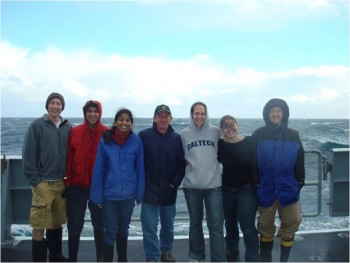Supporting Student Research

Adam Subhas ’09 (second from left) used his KINSC funding to participate in a National Science Foundation expedition in the southern ocean near Australia that examined coral samples for evidence of past climate changes.
Details
The Koshland Integrated Natural Sciences Center (KINSC) has some of the newest facilities on campus. And thanks to recent endowment support, the KINSC now joins Haverford's two other interdisciplinary centers--the Hurford Humanities Center and the Center for Peace and Global Citizenship – in funding student research. The fruits of that new funding were presented to Haverford's Board of Managers, during their October meeting on campus.
The event, held at the KINSC's Sharpless Auditorium, featured faculty and students and began with chemistry professor Karin Akerfeldt's report on her three-year KINSC grant for international collaborative research with Haverford students Winnifred Johnson '09 and Catherine Divizio '12 at Lund University in Sweden. The trio worked with professor Sara Linse there, and her team of students, on the structure and functions of the protein Calmodulin and its regulatory effects on Calcium in the cells of eukaryotic organisms.
Students Amy Labar '10 and Lauren VanArendonk ‘10 gave a presentation on their summer experience at Obafemi Awolowo University in Ile-Ife, Nigeria, where they conducted research in medical microbiology, and ran an intensive microbiology lab for Nigerian graduate students. Labar and VanArendonk also had research objectives of their own. Labar was working to understand antibiotic and antimicrobial resistance and also studied a cheaper alternative HIV test for Africa, which was later discovered to be less effective than the one used in Europe and the U.S. VanArendonk investigated E Coli and its interactions with its host organisms.
Associate Professor of Physics Suzanne Kane and Assistant Professor of Chemistry Joshua Schrier presented their project, which also received funding from the Center for Peace and Global Citizenship, to use solar panels as an educational resource. Their 300-level physics course engaged students in learning the theoretical and engineering challenges behind building a working photovoltaic solar energy unit. The solar energy system Kane and Schrier are developing through their class would provide 4,300 kilowatt hours over a year, would be tied to the electrical grid, and pay for itself in 10 years.
Fiona Shaw '10 told of her summer experience researching psychology and neuroscience at the University of Pennsylvania, with Dr. Anjan Chatterjee. Shaw researched directionality in memory, which she will use for her senior thesis, and also worked on a study of the interrelation of language and color perception.
Yusup Shin '11 reported on his summer internship at the Institut Pasteur in Paris, France, where he investigated the protein interactions associated with malaria infections in rodents. Shin received funding from both the KINSC and the Howard Hughes Medical Institute. His was the first international project from Haverford to be funded by the HHMI program.
Finally, Adam Subhas '09 used his KINSC funding to participate in a National Science Foundation cruise of the southern ocean near Australia to examine coral samples for evidence of past climate changes. Subhas was at sea for 33 days on the University of Washington research vessel Thomas G. Thompson with a remotely operated vehicle named“Jason.” The cruise found coral samples averaging 100 years of age and, by studying the nutrients embedded in the coral skeletons, discovered new information about climate change.
"With the wonderful success of our recently funded recipients, we hope to get the word out that these funding opportunities exist,” says KINSC director and associate professor of biology Rob Fairman.“We want faculty and students alike to feel encouraged to send us their best ideas for scholarly support."
-Andrew Thompson '12



